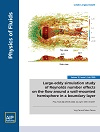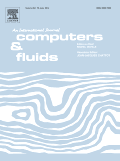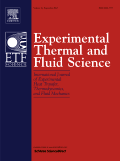
EXPERIMENTS IN FLUIDS
Scope & Guideline
Transforming experimental methodologies into groundbreaking applications.
Introduction
Aims and Scopes
- Experimental Fluid Dynamics:
The journal predominantly emphasizes experimental approaches in fluid dynamics, including the analysis of turbulence, flow separation, and boundary layer phenomena. - Innovative Measurement Techniques:
It showcases advancements in measurement techniques such as Particle Image Velocimetry (PIV), Laser-Induced Fluorescence (LIF), and background-oriented schlieren methods to capture fluid flow characteristics. - Multiphase and Reactive Flows:
Research often explores multiphase flow dynamics and interactions between different phases, including gas-liquid and solid-liquid interactions, which are crucial for various industrial applications. - Aeroacoustics and Noise Control:
The journal addresses the relationship between fluid dynamics and acoustic phenomena, particularly in the context of reducing noise in aerodynamic applications. - Heat Transfer and Thermodynamics:
Papers frequently investigate heat transfer mechanisms in fluid flows, especially in high-enthalpy environments relevant to aerospace and combustion applications. - Fluid-Structure Interaction:
Research includes studies on how fluid flows interact with solid structures, impacting performance and stability across various engineering disciplines.
Trending and Emerging
- Data-Driven Approaches:
There is a significant rise in studies employing machine learning and data-driven methodologies to analyze fluid dynamics, optimize experimental setups, and enhance measurement accuracy. - Advanced Imaging Techniques:
Emerging techniques such as digital holography and time-resolved imaging methods are gaining traction, allowing for more precise visualization of complex flow structures and interactions. - High-Performance Computing Integration:
Research increasingly integrates high-performance computing simulations with experimental data to validate models and enhance the understanding of fluid dynamics under various conditions. - Environmental Fluid Dynamics:
A growing focus on environmental applications, including the study of pollutant dispersion and fluid dynamics in natural water bodies, reflects a broader interest in ecological impacts. - Microfluidics and Nanoscale Flows:
Research on microfluidics and the behavior of fluids at the nanoscale is emerging, driven by applications in biomedical engineering and materials science. - Multiscale and Multiphysics Problems:
There is an increasing trend towards addressing multiscale and multiphysics problems in fluid dynamics, where interactions across different scales and physical processes are studied together.
Declining or Waning
- Simplistic Flow Models:
Research focusing on overly simplistic models of fluid dynamics appears to be waning, as there is a noticeable shift towards more complex and realistic simulations that consider multiple interacting variables. - Traditional Flow Measurement Techniques:
Established techniques that lack the precision and versatility of modern methods, such as PIV and LIF, are being phased out in favor of more innovative approaches that provide higher accuracy and resolution. - Static Flow Analysis:
The journal has shown a decline in papers that focus solely on static or steady-state flow analyses, with a growing preference for dynamic and transient flow studies that reflect real-world conditions.
Similar Journals

Propulsion and Power Research
Elevating Standards in Aerospace and Energy Discourses.Propulsion and Power Research, published by KEAI PUBLISHING LTD, is a leading Open Access journal that has been advancing the field of propulsion and power systems since its inception in 2012. With its commitment to fostering scientific discourse and innovation, the journal has gained a prominent position within academia, achieving a Q1 ranking in multiple categories such as Aerospace Engineering, Automotive Engineering, and Fluid Flow and Transfer Processes as of 2023. With an impressive ranking of #18 out of 153 in Aerospace Engineering and consistent recognition in the Scopus rankings, the journal explores critical advancements and research findings that propel the industry forward. As an Open Access publication, it ensures that groundbreaking research is readily available to a broad audience, enhancing collaboration between researchers, practitioners, and students. The journal's scope encompasses a wide range of topics within propulsion and energy solutions, making it an essential resource for anyone keen on discovering significant developments in this dynamic field.

Flow
Exploring innovative solutions in fluid flow and transfer processes.Flow is a premier open access journal published by Cambridge University Press, dedicated to advancing research in the fields of Aerospace Engineering, Biomedical Engineering, and Fluid Flow and Transfer Processes. Launched in 2021, Flow has rapidly gained recognition and has achieved a prestigious Q1 ranking in its categories for 2023, underscoring its influential role in disseminating high-quality research. With an emerging impact factor and a strong commitment to accessibility, the journal provides a crucial platform for researchers, professionals, and students to share innovative findings and foster collaboration across disciplines. Flow is headquartered in the United Kingdom and is part of Cambridge University's effort to promote scholarly communication that transcends traditional barriers. Whether you are looking to submit your work or explore cutting-edge studies in your field, Flow offers a dynamic and rigorous environment for intellectual exchange.

Fluid Dynamics
Pioneering insights in mechanical and fluid phenomena.Fluid Dynamics is a distinguished journal that has been at the forefront of research in the field of fluid flow and transfer processes since its inception in 1966. Published by MAIK NAUKA/INTERPERIODICA/SPRINGER, this journal serves as a valuable platform for engineers, scientists, and researchers dedicated to advancing the understanding of mechanical and fluid dynamic phenomena. With a Q3 ranking in key categories such as Fluid Flow and Transfer Processes, Mechanical Engineering, and Physics and Astronomy, Fluid Dynamics holds a significant position in the academic community, attracting submissions that push the boundaries of knowledge and application. Although it does not currently offer open access options, the journal is recognized for its robust editorial standards and impactful contributions to the field, making it essential reading for anyone involved in fluid dynamics research. Given its consistent publication through to 2024, Fluid Dynamics continues to inspire innovation and collaboration in an ever-evolving scientific landscape.

PHYSICS OF FLUIDS
Innovating Insights in Fluid PhysicsPHYSICS OF FLUIDS is a premier journal published by AIP Publishing that serves as a vital resource for the fluid mechanics community. With an impressive impact factor and a consistent ranking in the Q1 quartile across multiple related disciplines—including Computational Mechanics, Condensed Matter Physics, Fluid Flow and Transfer Processes, Mechanical Engineering, and Mechanics of Materials—this journal is renowned for disseminating high-quality research in the dynamic field of fluid dynamics. Covering a wide range of topics, from fundamental fluid mechanics to advanced computational modeling, PHYSICS OF FLUIDS plays a crucial role in advancing understanding and fostering innovation in both academic and industrial applications. With its strong reputation and significant readership, this journal is essential for researchers, professionals, and students seeking to stay updated on the latest developments in fluid physics.

FLOW TURBULENCE AND COMBUSTION
Bridging theory and practice in fluid dynamics research.Flow Turbulence and Combustion is a premier peer-reviewed journal published by Springer, focusing on the intricate dynamics of fluid mechanics, turbulence, and combustion phenomena. With an impressive impact factor and categorized in the Q1 quartile across Chemical Engineering, Physical and Theoretical Chemistry, and Physics and Astronomy, this journal serves as an invaluable resource for researchers, professionals, and students engaged in these fields. Founded in 1996, it presents cutting-edge research, comprehensive reviews, and innovative methodologies that advance the understanding of turbulent flow and combustion processes. The journal's commitment to open access ensures broad dissemination of knowledge, fostering greater collaboration and advancement in scientific inquiry. Based in the Netherlands, Flow Turbulence and Combustion continues to serve as a crucial platform for reporting significant findings and developments until 2024, appealing to a global audience passionate about fluid dynamics.

COMPUTERS & FLUIDS
Unveiling Cutting-Edge Insights in Computer Science and EngineeringCOMPUTERS & FLUIDS, published by PERGAMON-ELSEVIER SCIENCE LTD, is a premier journal in the fields of Computer Science and Engineering, with a distinguished history dating back to 1973. Its Q1 ranking in both Computer Science (Miscellaneous) and Engineering (Miscellaneous) illustrates its high impact and relevance, being positioned among the top tier of scientific publications. With a robust focus on the intersection of computational methods and fluid dynamics, this journal serves as a vital platform for researchers, professionals, and students dedicated to advancing knowledge and technology within these domains. Although it is not an open-access journal, its articles are accessible through various academic institutions and libraries, ensuring that vital research reaches its intended audience. Readers can explore innovative methodologies and applications, reinforcing the journal's commitment to enhancing the understanding of fluid mechanics through cutting-edge computational approaches. For more details, visit the official website of COMPUTERS & FLUIDS to stay abreast of the latest research advancements.

Experimental and Computational Multiphase Flow
Innovating Research in Multiphase Fluid DynamicsExperimental and Computational Multiphase Flow, published by SpringerNature, is a prestigious academic journal that critically examines advancements in the field of fluid dynamics, with a specialized focus on multiphase flow phenomena. Since its inception in 2019, the journal has established a remarkable reputation, attaining Q1 status in Fluid Flow and Transfer Processes as well as Mechanical Engineering according to the 2023 category quartiles, reflecting its high impact and relevance in these domains. With Scopus rankings placing it among the top 15 journals in both Chemical Engineering and Nuclear Energy and Engineering, Experimental and Computational Multiphase Flow is an essential resource for researchers, professionals, and students engaged in cutting-edge studies and applications. Although it operates on a subscription model, the journal remains dedicated to disseminating high-quality research and fostering a deeper understanding of complex fluid interactions across various scientific disciplines. By prioritizing innovative methodologies and interdisciplinary collaborations, the journal aims to significantly contribute to the ongoing evolution of multiphase flow research, recognizing its critical importance in engineering and energy sectors.

Fluids
Elevating research visibility in fluid flow and mechanical engineering.Fluids is a leading open-access journal published by MDPI that commenced its publication in 2016, fostering a vibrant platform for the dissemination of high-quality research in the fields of Condensed Matter Physics, Fluid Flow and Transfer Processes, and Mechanical Engineering. Based in Switzerland, the journal has earned a prominent reputation, achieving a Q2 categorization in the latest 2023 rankings, indicating its significant impact within respective subject areas. Researchers and professionals will find Fluids an invaluable resource, as it not only facilitates the sharing of innovative studies but also provides open access to research findings, ensuring widespread visibility and utility. With a diversified editorial board and a commitment to exploration in fluid dynamics and related applications, Fluids aims to advance knowledge, foster collaboration, and inspire future research endeavors among its readership. As the journal converges into new frontiers from 2016 to 2024, it continues to be a pivotal reference for scholars and practitioners alike.

EXPERIMENTAL THERMAL AND FLUID SCIENCE
Unleashing the potential of experimental techniques in engineering.EXPERIMENTAL THERMAL AND FLUID SCIENCE is a prestigious academic journal published by Elsevier Science Inc, dedicated to advancing the fields of thermal and fluid sciences. With a strong focus on innovative experimental research, it plays a crucial role in disseminating new knowledge and techniques across multiple domains, including Aerospace Engineering, Chemical Engineering, Fluid Flow and Transfer Processes, Mechanical Engineering, and Nuclear Engineering. Holding a notable impact factor and ranking in the Q1 quartile across these categories since 2023, the journal is recognized for its high-quality contributions, which appeal to a diverse audience of researchers, industry professionals, and students alike. Additionally, with dedicated coverage from its inception in 1988 to projections extending through 2025, EXPERIMENTAL THERMAL AND FLUID SCIENCE provides a vital platform for sharing advancements in experimental techniques and findings that shape the future of engineering and applied sciences.

JOURNAL OF FLOW VISUALIZATION AND IMAGE PROCESSING
Transforming Data into Insightful Flow VisualizationsThe Journal of Flow Visualization and Image Processing, published by Begell House Inc, serves as a pivotal forum for scholars and practitioners in the fields of computer science applications, condensed matter physics, and mechanical engineering. Since its inception in 1996, this journal has been dedicated to advancing the understanding of fluid dynamics through visualization techniques and image processing methodologies. With a publication trajectory extending to 2024, the journal has established a solid reputation, reflected in its Q3 categorization across multiple disciplines as of 2023, indicating its relevance and contribution to current research paradigms. Although it is not an open-access journal, it offers invaluable insights and findings that are critical for researchers, professionals, and students alike who are interested in the complexities of flow phenomena and their applications. The journal's commitment to disseminating high-quality research—despite its current rankings, which show room for improvement—underscores its potential for growth and the vital role it plays in fostering innovation within the scientific community.